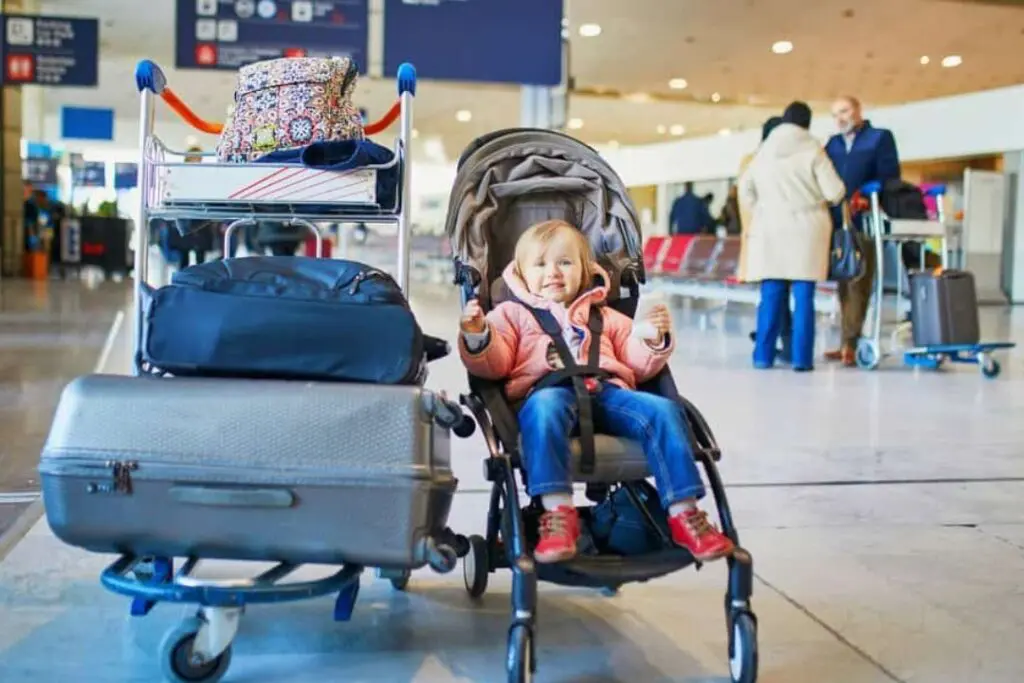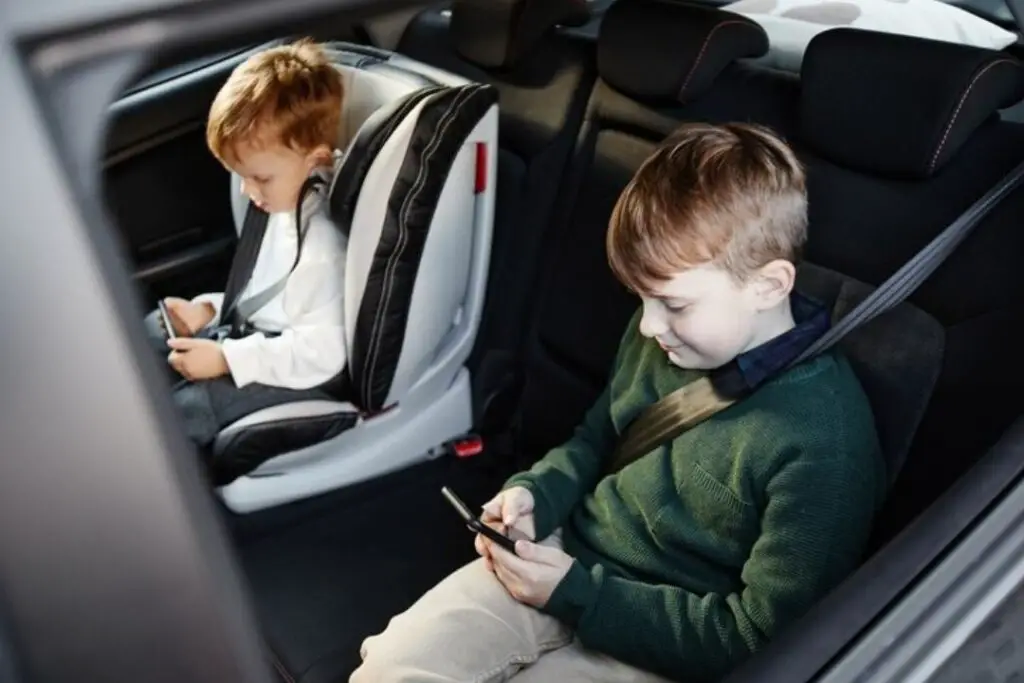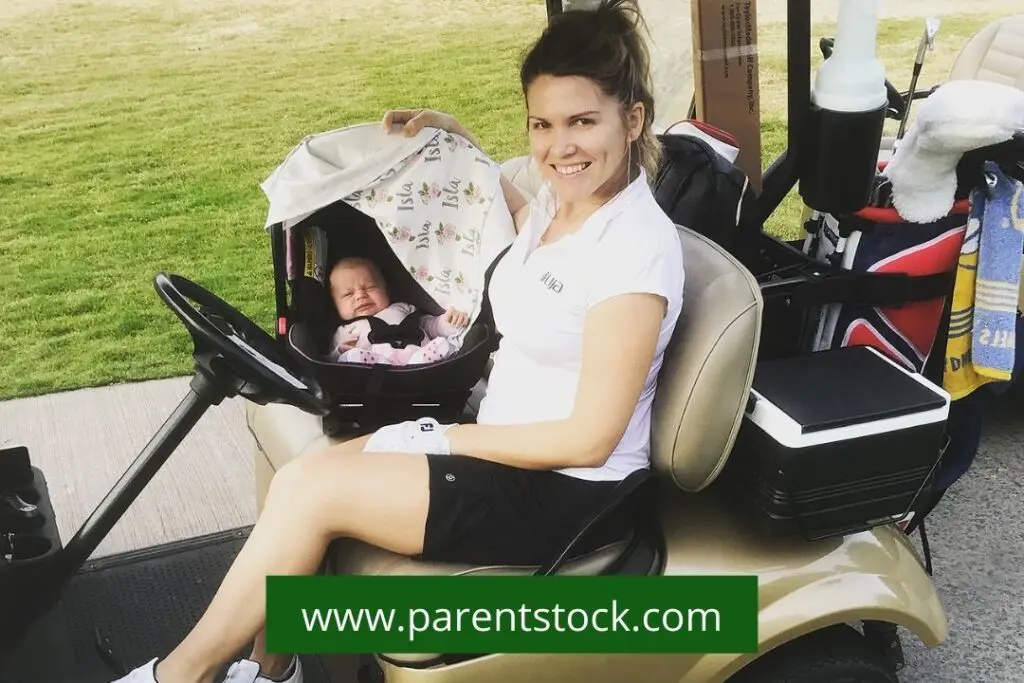When flying with a car seat it is essential to consider their safety and comfort. One way to ensure both is to bring a car seat on the flight and use it during takeoff, landing, and any other time the seatbelt sign is on. This will not only provide a familiar and secure environment for your child.
When bringing a car seat on a flight, it is essential to note that it must be FAA approved and have a label indicating such.
Additionally, it is recommended to bring a copy of the car seat’s manual or instructions. Some airlines may require this information. Getting a separate bag to store the car seat while not in use is also a good idea. I’t can take up extra space in overhead compartments.
Some airlines may also allow you to gate check the car seat instead of bringing it on board. But it is best to check with your airline for their specific policies. It is also important to note that if you plan to use the car seat on a connecting flight. Moreover, check with the airlines for their policies. Different airlines may have different regulations.
In this blog post your will learn all about flying with a car seat.
Proper installation and securing of the car seat on the plane
Proper installation and securing of a car seat on a plane is crucial to ensure the safety of your child during the flight. The FAA recommends that children under the age of 2 should be in a rear-facing car seat on the plane. For older children, a forward-facing car seat or a booster seat can be used.
Before the flight or flying with a car seat, it is important to make sure the car seat is approved for use on airplanes. It is the appropriate size for your child.
When installing the car seat on the plane, it should be placed in a window seat, as it provides the most stability. The seat should be securely fastened to the airplane seat using the seat belt. Ensuring that the lap belt is low and tight acros the child’s hips. The shoulder belt is snug across the child’s chest.
When properly installed and secured, the car seat should only move an inch in any direction. It is also recommended to check with the airline on the availability of the car seat belt on the plane, as some older planes may still need them.
All airlines allow car seats on planes, and some may have different policies and requirements. It is best to check with the airline to ensure you have all the necessary information and equipment before your flight.
In summary,when flying with a car seat properly installing and securing a car seat on a plane is essential for your child’s safety during the flight. Before flying with a car seat It is important to check the regulations and guidelines, the availability of car seat belts, the appropriate size and safety of the car seat, the proper installatio own car seat vs renting at destination
Own car seat vs Rental car seat
When traveling with a child, one of the decisions parents have to make is whether to bring their own car seat or rent one at their destination. Both options have their own advantages and disadvantages, and the best choice depends on the individual family’s needs and preferences.
Bringing your own car seat from home can provide peace of mind. Your child will be in a seat that is familiar and has been properly maintained. It also ensures that the seat is compatible with the vehicle you’ll be using during your trip. Additionally, it eliminates the need to rent a car seat, which can save money and time.
On the other hand, renting a car seat at your destination can be more convenient. It will eliminate the need to lug the car seat through the airport and on the plane. It also allows you to avoid the hassle of checking the car seat as baggage, which can get lost or damaged during transit. Furthermore, some rental car companies may provide car seats at no extra cost.
When considering renting a car seat at your destination, it’s essential to do your research in advance. Not all car rental companies offer car seats, and those that do may have different policies and requirements. It is essential to check the quality and safety of the car seats provided, as some may need to meet the safety standards of your own car seat.
Factors to consider when choosing a car seat for air travel
When choosing a car seat for air travel, there are several factors to consider to ensure the safety and comfort of your child during the flight. One of the most important factors is the age and weight of your child. The FAA recommends that children under the age of 2 should be in a rear-facing car seat on the plane.
The older children can use a forward-facing car seat or a booster seat. It is also important to check that the car seat is approved for use on airplanes, which will be indicated by a label or sticker on the seat.
Another factor to consider is the size and weight of the car seat. It is crucial to choose a car seat that is lightweight and easy to carry. It will need to be transported through the airport and on the plane. Additionally, it should be compatible with the airplane seat and the seatbelt provided on the plane.
Another important factor to consider is the adjustability of the car seat. It should be adjustable to your child’s size and position to ensure a proper fit and comfort during the flight.
Finally, it is worth checking the ease of use of the car seat. Look for a car seat that is easy to install and secure on the plane . Easy to adjust and clean.
Tips for packing and carrying your car seat during travel.
When flying with car seat, there are several tips to keep in mind. To make the process as easy and stress-free as possible: There are many tips and tricks to pack car seat but most important are given below.
- Pack the car seat in its own travel bag, if it has one. This will protect it from scratches and dirt during travel.
- Use a luggage cart or a rolling suitcase to transport the car seat through the airport. This will make it easier to maneuver and reduce the strain on your arms and shoulders.
- Consider using a backpack or a shoulder bag to carry the car seat on the plane. This will keep your hands free to manage other luggage or hold your child.
- Pack a few essentials for your child in the car seat, such as a blanket, a toy, or a snack. This will make the car seat more comfortable for your child. It will save you from having to carry it separately.
- Check the car seat in as baggage. This will free up your hands and make it easier to maneuver through the airport. However, be aware that checked baggage can get lost or damaged during transit. Make sure to have a plan B in case your car seat doesn’t reach your destination.
- If you are traveling internationally, check the regulations and guidelines for car seat usage in the country you are visiting.
Installing the car seat in a rental car or taxi after landing.
Installing a car seat in a rental car or taxi after landing can be challenging. Especially if the car seat is unfamiliar. Here are some tips to make the process as easy and safe as possible:
- Before renting a car, make sure that the car rental company provides car seats . Check if they have any additional fees for car seat rental.
- Familiarize yourself with the car seat before you leave the airport. Look at the instruction manual and ensure you understand how to install and adjust the seat.
- Ensure the rental car is equipped with the necessary anchors and LATCH (Lower Anchors and Tethers for Children) system if the car seat needs it.
- Take the time to properly install the car seat in the rental car. Ensure the seat is level and at the correct angle. The harness is tight and secure around your child.
- Double-check that the car seat is properly installed and that your child is securely fastened before starting the drive.
- If you are using a taxi, you can bring your own car seat . You can request a taxi with a car seat. Make sure to properly install the car seat and secure your child.
- Lastly, it is important to make sure that the car seat you are using is appropriate for the child’s age, size, and weight and that it is approved for use in the country you are visiting.
How to entertain and comfort your child during the flight.
Entertaining and comforting your child during a flight can be a challenge, but there are several strategies you can use to make the experience as smooth and stress-free as possible:
- Bring familiar and favorite toys, games, books, or videos for your child to play with during the flight.
- Pack snacks such as fruit, crackers, or granola bars to keep your child’s hunger at bay.
- Bring a comfort item, such as a blanket or a stuffed animal, to help your child feel more secure and relaxed.
- Please encourage your child to use headphones or earplugs to reduce noise and help them sleep better.
- Consider bringing a small pillow or a cushion for your child to rest their head during the flight.
- Book a window seat for your child, as the view can be a great distraction and source of entertainment.
- Encourage your child to walk around and stretch their legs every hour or so, as it can help them feel more comfortable and prevent jet lag.
- Prepare your child for the flight by explaining what to expect during the flight and how long it will take.
- Bring a change of clothes for your child in case of any accidents or spills.
- Try to schedule your flight at a time when your child usually sleeps to reduce the chances of them getting restless or fussy during the flight.
Handling flight delays and cancellations while traveling with a car seat
Handling flight delays and cancellations while traveling with a car seat can be stressful, but there are several strategies you can use to minimize the inconvenience and ensure the safety and comfort of your child:
- Be prepared for unexpected delays and cancellations by packing essentials for your child, such as snacks, extra clothes, and entertainment items.
- Keep important documents, such as your flight itinerary and car seat instructions, in an easily accessible place.
- If your flight is delayed, check with the airline to see if they can provide accommodations, such as a hotel or meal vouchers.
- If your flight is cancelled, contact the airline immediately to rebook your flight or request a refund.
- If you have to spend the night in an airport or hotel, bring a portable crib or pack-n-play to provide a comfortable and safe sleeping environment for your child.
- If you have to take a different flight, make sure the new flight has the availability of a car seat belt and if not, consider bringing your own car seat.
- Be prepared for the possibility of having to rent a car seat at your destination in case your own car seat gets lost or damaged during transit.
- Have a plan B if your car seat doesn’t make it to your destination, such as buying a new one or borrowing from a friend or family member.
- Stay calm and informed about any changes or updates to your flight to reduce stress and uncertainty.
- Consider purchasing travel insurance that includes coverage for flight cancellations and lost or delayed baggage.
Conclusion
In conclusion, flying with a car seat can be challenging, but it is crucial to ensure the safety and comfort of your child. Proper installation and securing the car seat on the plane, choosing the right car seat for travel.
Packing and carrying the car seat, preparing your child for the flight, and handling unexpected situations such as flight delays and cancellations are key considerations when traveling with a car seat.
It is also important to be aware of regulations and guidelines for using a car seat on a plane. To check with the airline in advance for their policies. By following these tips and being prepared, you can make the experience as stress-free and enjoyable as possible for both you and your child.




